In celebration of National Video Game Day, shareholder and Patent Arcade author Kirk Sigmon visits the fun, old, occasionally weird, and oftentimes important video game patents that have shaped how we play our favorite games today. You can learn more about the video game patents we’ve found as part of our ongoing analysis of the world of video game patents on our Patent Arcade Blog.

U.S. Pat. No. 6,935,954 – The Sanity System for Video Games
It might sound strange, but Nintendo has a patent on a sanity-level system in a video game. While the patent drawings in the ’954 Patent suggest that the sanity system might have been originally intended for use in the Legend of Zelda series, the system was in fact implemented in the game Eternal Darkness: Sanity’s Requiem. In short, the more scared your in-game character becomes, fun and strange things happen: for example, the game will pretend to delete your saved games, and/or the game will pretend to take over control of your television.

U.S. Pat. No. 6,231,444 – The Sony DualShock Controller Patent
Sony has infamously maintained roughly the same controller design since the original PlayStation, but they’ve made a number of small tweaks and improvements along the way. Along those lines, the ’444 Patent relates to the original DualShock controller for the first PlayStation, which included (among other improvements) multiple analog sticks and “vibration imparting mechanism[s]” for “imparting vibrations to the user’s hands.” Games like Ape Escape relied heavily on these features.

U.S. Pat. No. 6,331,146 – The Nintendo 64 and Super Mario 64 Patent
The ’146 Patent is one big collection of different ideas for the Nintendo 64 console and the game Super Mario 64. The patent is quite lengthy and describes multiple concepts that would become incredibly important towards making Super Mario 64 a good game, such as: the star system (including preventing access to levels based on the number of stars Mario has collected), the design of the Nintendo 64 controller (including the internal components of the joystick), and even the features of the minigame in Super Mario 64 where you can deform Mario’s face. It’s a truly massive patent, and an example of how innovative the Nintendo 64 was.

U.S. Pat. No. 8,082,499 – The Mass Effect and Dragon Age Dialogue Wheel
Believe it or not, the dialogue wheel used in the Mass Effect and Dragon Age video games is patented. One key aspect of the patent seems to be the idea that directional choices on the wheel correspond to specific dialogue responses, with a further focus on the idea that dialogue options corresponding to particular emotional responses (e.g., happy, angry) are always oriented in a similar direction. For example, in Mass Effect, friendly (“Paragon”) dialogue options tend to be upward to the left/right, hostile (“Renegade”) dialogue options tend to be downward to the left/right, and inquisitive/neutral answers tend to be more centrally located.
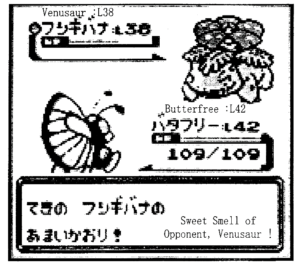
U.S. Pat. No. 6,251,010 – The Pokémon Spawn Rate Patent
Among other patents related to the game series Pokémon, this Nintendo and Game Freak patent illustrates how one of the earlier Pokémon games might have varied the likelihood of certain characters (that is, Pokémon) to appear in a particular territory based on a time of day. Other patents (such as this patent, filed around the same time) relate to other features in the Pokémon games, such as the idea of a transmittable “Pokémon virus” (“Pokérus”).
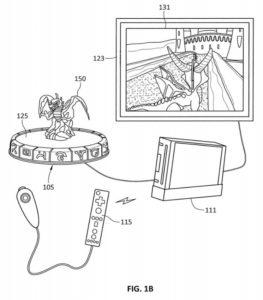
U.S. Pat. No. 10,561,953 – Skylanders and Toys to Life
The ’953 Patent is an example of one of the many patents relating to the somewhat-dead “toys-to-life” video game genre, which includes Activision’s Skylanders video game series. The ’953 Patent describes adding rewritable memories to toys such that game data can be stored on the toy. That information could include, for example, information about the character represented by the toy, scores, experience levels, weapons, captured/defeated characters, and the like.

U.S. Pat. No. 5,184,830 – The Original Game Boy Patent
The Game Boy was and continues to be a massive success, and–perhaps unsurprisingly–the original Game Boy design is patented. Features described in the patent include the ability to use cartridges to access game data, the particular layout of the buttons, and the particularities of the screen. Strangely, the device is described as “having a subsonically rectangularly shape,” whatever that means.
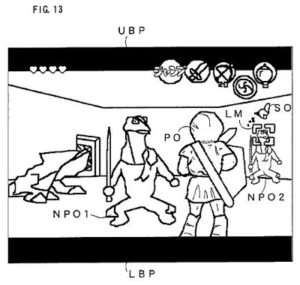
U.S. Pat. No. 6,626,760 – Nintendo’s “Z-Targeting” Patent for Zelda 64
One important quality-of-life feature in Nintendo’s smash hit Nintendo 64 game The Legend of Zelda: Ocarina of Time was the ability to use “Z-Targeting”– that is, the ability to make Link focus his attention (and the camera) on an object of interest in the 3D environment. The ’760 Patent, generically titled “Video Game Apparatus and Memory Medium Therefor,” describes exactly that, except in some very generic language, and using some totally-Zelda-but-not-supposed-to-be-Zelda artwork.
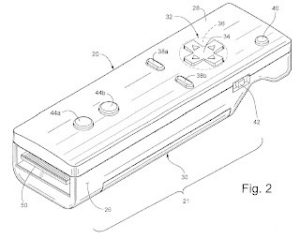
U.S. Pat. No. 8,313,379 – The Wiimote Patent
Continuing the theme of ultra-popular Nintendo hardware patents, the ’379 Patent is an example of one of Nintendo’s patents relating to the Wii Remote, also known as the “Wiimote.” The key features described by the patent include the ability to use the controller in one-handed and two-handed modes, the wireless connectivity of the controller, the use of “light emitting marker[s]” near a display screen, and use of an accelerometer.
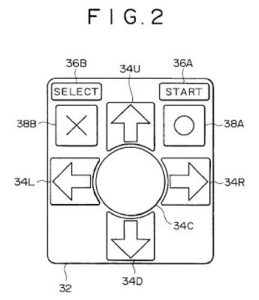
U.S. Pat. No. 6,695,694 – The Dance Dance Revolution (“DDR”) Patent
The ’694 Patent describes the foundation of the hit game Dance Dance Revolution: specifically, it describes a process involving a user stepping on a game pad in accordance with game music. This particular patent focuses on the health benefits of the game–for example, claim 1 seemingly focuses on letting a player know how many calories they’ve burned while dancing. Caloric burn was touted as a major benefit of Dance Dance Revolution, and there have been numerous studies showing the benefits of these games.

